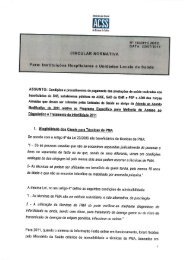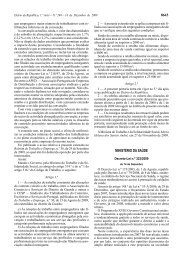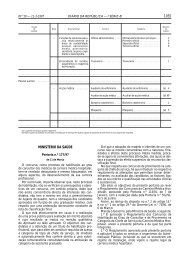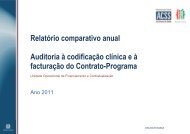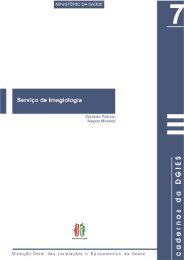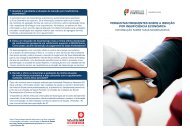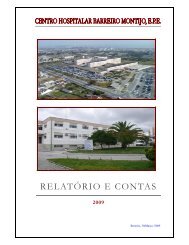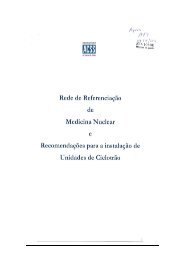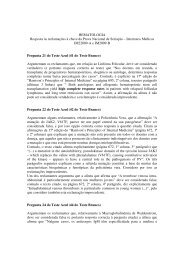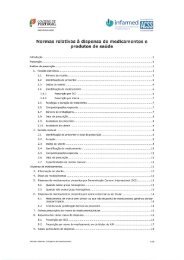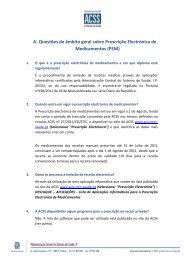Understanding the ICD-10-PCS Guidelines - ACSS
Understanding the ICD-10-PCS Guidelines - ACSS
Understanding the ICD-10-PCS Guidelines - ACSS
You also want an ePaper? Increase the reach of your titles
YUMPU automatically turns print PDFs into web optimized ePapers that Google loves.
Preparing for <strong>ICD</strong>-<strong>10</strong>:<br />
<strong>Understanding</strong> <strong>the</strong> <strong>ICD</strong>-<strong>10</strong>-<strong>PCS</strong><br />
<strong>Guidelines</strong><br />
Nelly Leon-Chisen, RHIA<br />
Director, Coding and Classification
Learning Objectives<br />
• Learn <strong>the</strong> General <strong>ICD</strong>-<strong>10</strong>-<strong>PCS</strong> Coding <strong>Guidelines</strong><br />
• Understand <strong>the</strong> <strong>ICD</strong>-<strong>10</strong>-<strong>PCS</strong> Coding <strong>Guidelines</strong> for <strong>the</strong><br />
Medical and Surgical Section including:<br />
– Body system guidelines<br />
– Root operation guidelines<br />
– Body part guidelines<br />
– Approach guidelines<br />
– Device guidelines<br />
• Review surgical examples from Coding Clinic for <strong>ICD</strong>-9-CM<br />
applying <strong>the</strong> <strong>ICD</strong>-<strong>10</strong>-<strong>PCS</strong> Coding <strong>Guidelines</strong><br />
Copyright (c) 20<strong>10</strong> by American Hospital Association. All rights reserved.<br />
2
Guideline Organization<br />
A. Conventions<br />
B. Medical and Surgical section guidelines<br />
2. Body system guidelines<br />
3. Root operation guidelines<br />
4. Body part guidelines<br />
5. Approach guidelines<br />
6. Device guidelines<br />
C. O<strong>the</strong>r medical and surgical-related sections<br />
Copyright (c) 20<strong>10</strong> by American Hospital Association. All rights reserved.<br />
3
Conventions: A1<br />
<strong>ICD</strong>-<strong>10</strong>-<strong>PCS</strong> codes are composed of seven characters. Each<br />
character is an axis of classification that specifies information<br />
about <strong>the</strong> procedure performed. Within a defined code range, a<br />
character specifies <strong>the</strong> same type of information in that axis of<br />
classification.<br />
1 2 3 4 5 6 7<br />
Section<br />
Root<br />
Operation<br />
Approach<br />
Device<br />
Qualifier<br />
Body<br />
System<br />
Body Part<br />
Copyright (c) 20<strong>10</strong> by American Hospital Association. All rights reserved.<br />
4
Conventions: A2<br />
One of 34 possible values can be assigned to each axis of<br />
classification in <strong>the</strong> seven-character code: <strong>the</strong>y are <strong>the</strong><br />
numbers 0 through 9 and <strong>the</strong> alphabet (except I and O<br />
because <strong>the</strong>y are easily confused with <strong>the</strong> numbers 1 and 0).<br />
The number of unique values used in an axis of classification<br />
differs as needed.<br />
Approach Examples:<br />
0 Open<br />
2 Open endoscopic<br />
3 Percutaneous<br />
4 Percutaneous endoscopic<br />
7 Via natural or artificial opening<br />
8 Via natural or artificial opening endoscopic<br />
X External<br />
Copyright (c) 20<strong>10</strong> by American Hospital Association. All rights reserved.<br />
5
Conventions: A3<br />
The valid values for an axis of classification can be added to<br />
as needed.<br />
Example: If a significantly distinct type of device is used in a<br />
new procedure, a new device value can be added to <strong>the</strong><br />
system.<br />
Copyright (c) 20<strong>10</strong> by American Hospital Association. All rights reserved.<br />
6
Conventions: A4<br />
As with words in <strong>the</strong>ir context, <strong>the</strong> meaning of any single<br />
value is a combination of its axis of classification and any<br />
preceding values on which it may be dependent.<br />
Examples:<br />
• Body part value 0 in Central Nervous System = Brain<br />
00B00ZX Excision of Brain, Open Approach, Diagnostic<br />
• Body part value 0 in Peripheral Nervous Body System = Cervical<br />
Plexus<br />
01B00ZX - Excision of Cervical Plexus, Open Approach,<br />
Diagnostic<br />
Copyright (c) 20<strong>10</strong> by American Hospital Association. All rights reserved.<br />
7
Example<br />
0 0 B 0 0 Z X<br />
Section<br />
Root<br />
Operation<br />
Approach<br />
Qualifier<br />
Medical<br />
and<br />
Surgical<br />
Body<br />
System<br />
Central<br />
Nervous<br />
System<br />
Excision<br />
Body Part<br />
Brain<br />
Open<br />
Device<br />
No device<br />
Diagnostic<br />
Example:<br />
• Body part value 0 in Central Nervous System = Brain<br />
00B00ZX Excision of Brain, Open Approach, Diagnostic<br />
Copyright (c) 20<strong>10</strong> by American Hospital Association. All rights reserved.<br />
8
Example<br />
0 1 B 0 0 Z X<br />
Section<br />
Root<br />
Operation<br />
Approach<br />
Qualifier<br />
Medical<br />
and<br />
Surgical<br />
Body<br />
System<br />
Peripheral<br />
Nervous<br />
System<br />
Excision<br />
Body Part<br />
Cervical<br />
Plexus<br />
Open<br />
Device<br />
No device<br />
Diagnostic<br />
• Body Part value 0 in Peripheral Nervous Body System = Cervical Plexus<br />
01B00ZX - Excision of Cervical Plexus, Open Approach, Diagnostic<br />
Copyright (c) 20<strong>10</strong> by American Hospital Association. All rights reserved.<br />
9
Conventions: A5<br />
As <strong>the</strong> system is expanded to become increasingly detailed,<br />
over time more values will depend on preceding values for<br />
<strong>the</strong>ir meaning.<br />
Example: In <strong>the</strong> Lower Joints body system, <strong>the</strong> device value 3 in<br />
<strong>the</strong> root operation Insertion specifies Infusion Device and <strong>the</strong><br />
device value 3 in <strong>the</strong> root operation Fusion specifies Interbody<br />
Fusion Device.<br />
Copyright (c) 20<strong>10</strong> by American Hospital Association. All rights reserved.<br />
<strong>10</strong>
Conventions: A6 – A9<br />
The purpose of <strong>the</strong> alphabetic index is to locate <strong>the</strong> appropriate<br />
table that contains all information necessary to construct a<br />
procedure code. The <strong>PCS</strong> Tables should always be consulted to<br />
find <strong>the</strong> most appropriate valid code.<br />
It is not required to consult <strong>the</strong> index first before proceeding to <strong>the</strong><br />
tables to complete <strong>the</strong> code. A valid code may be chosen directly<br />
from <strong>the</strong> tables.<br />
All seven characters must be specified to be a valid code. If <strong>the</strong><br />
documentation is incomplete for coding purposes, <strong>the</strong> physician<br />
should be queried for <strong>the</strong> necessary information.<br />
Within a <strong>PCS</strong> table, valid codes include all combinations of choices<br />
in characters 4 through 7 contained in <strong>the</strong> same row of <strong>the</strong> table.<br />
Copyright (c) 20<strong>10</strong> by American Hospital Association. All rights reserved.<br />
11
Sample Alphabetical Index Entries<br />
Copyright (c) 20<strong>10</strong> by American Hospital Association. All rights reserved.<br />
12
Sample Alphabetical Index Entries (cont.)<br />
Copyright (c) 20<strong>10</strong> by American Hospital Association. All rights reserved.<br />
13
Sample <strong>ICD</strong>-<strong>10</strong>-<strong>PCS</strong> Table<br />
Copyright (c) 20<strong>10</strong> by American Hospital Association. All rights reserved.<br />
14
Conventions: A<strong>10</strong><br />
“And,” when used in a code description, means “and/or.”<br />
Example: Lower Arm and Wrist Muscle means lower arm<br />
and/or wrist muscle.<br />
Copyright (c) 20<strong>10</strong> by American Hospital Association. All rights reserved.<br />
15
Conventions: A11<br />
Many of <strong>the</strong> terms used to construct <strong>PCS</strong> codes are defined<br />
within <strong>the</strong> system. It is <strong>the</strong> coder’s responsibility to<br />
determine what <strong>the</strong> documentation in <strong>the</strong> medical record<br />
equates to in <strong>the</strong> <strong>PCS</strong> definitions. The physician is not<br />
expected to use <strong>the</strong> terms used in <strong>PCS</strong> code descriptions,<br />
nor is <strong>the</strong> coder required to query <strong>the</strong> physician when <strong>the</strong><br />
correlation between <strong>the</strong> documentation and <strong>the</strong> defined <strong>PCS</strong><br />
terms is clear.<br />
Copyright (c) 20<strong>10</strong> by American Hospital Association. All rights reserved.<br />
16
Example<br />
• Example: When <strong>the</strong> physician documents “partial resection”<br />
<strong>the</strong> coder can independently correlate “partial resection” to<br />
<strong>the</strong> root operation Excision without querying <strong>the</strong> physician<br />
for clarification.<br />
Copyright (c) 20<strong>10</strong> by American Hospital Association. All rights reserved.<br />
17
Guideline Organization<br />
A. Conventions<br />
B. Medical and Surgical section guidelines<br />
2. Body system guidelines<br />
3. Root operation guidelines<br />
4. Body part guidelines<br />
5. Approach guidelines<br />
6. Device guidelines<br />
C. O<strong>the</strong>r medical and surgical-related sections<br />
Copyright (c) 20<strong>10</strong> by American Hospital Association. All rights reserved.<br />
18
Body System: General <strong>Guidelines</strong><br />
B2.1a<br />
The procedure codes in <strong>the</strong> general anatomical regions<br />
body systems should only be used when <strong>the</strong> procedure is<br />
performed on an anatomical region ra<strong>the</strong>r than a specific<br />
body part (e.g., root operations Control and Detachment,<br />
drainage of a body cavity) or on <strong>the</strong> rare occasion when no<br />
information is available to support assignment of a code to a<br />
specific body part.<br />
Example: Control of postoperative hemorrhage is coded to <strong>the</strong><br />
root operation Control found in <strong>the</strong> general anatomical regions<br />
body systems.<br />
Copyright (c) 20<strong>10</strong> by American Hospital Association. All rights reserved.<br />
19
Body System General <strong>Guidelines</strong> (cont.)<br />
B2.1b<br />
Body systems designated as upper or lower contain body<br />
parts located above or below <strong>the</strong> diaphragm respectively.<br />
Example: Vein body parts above <strong>the</strong> diaphragm are found in <strong>the</strong><br />
Upper Veins body system; vein body parts below <strong>the</strong> diaphragm<br />
are found in <strong>the</strong> Lower Veins body system.<br />
Copyright (c) 20<strong>10</strong> by American Hospital Association. All rights reserved.<br />
20
Root Operation: General <strong>Guidelines</strong><br />
B3.1a<br />
In order to determine <strong>the</strong> appropriate root operation, <strong>the</strong> full<br />
definition of <strong>the</strong> root operation as contained in <strong>the</strong> <strong>PCS</strong><br />
Tables must be applied.<br />
Copyright (c) 20<strong>10</strong> by American Hospital Association. All rights reserved.<br />
21
Root Operation: General <strong>Guidelines</strong> (cont)<br />
B3.1b<br />
Components of a procedure specified in <strong>the</strong> root operation<br />
definition and explanation are not coded separately.<br />
Procedural steps necessary to reach <strong>the</strong> operative site and<br />
close <strong>the</strong> operative site are also not coded separately.<br />
Example: Resection of a joint as part of a joint replacement<br />
procedure is included in <strong>the</strong> root operation definition of<br />
Replacement and is not coded separately. Laparotomy<br />
performed to reach <strong>the</strong> site of an open liver biopsy is not<br />
coded separately.<br />
Copyright (c) 20<strong>10</strong> by American Hospital Association. All rights reserved.<br />
22
Example<br />
Copyright (c) 20<strong>10</strong> by American Hospital Association. All rights reserved.<br />
23
Root Operation <strong>Guidelines</strong>: Multiple<br />
Procedures<br />
B3.2 During <strong>the</strong> same operative episode, multiple procedures<br />
are coded if:<br />
a. The same root operation is performed on different body<br />
parts as defined by distinct values of <strong>the</strong> body part<br />
character.<br />
b. The same root operation is repeated at different body<br />
sites that are included in <strong>the</strong> same body part value.<br />
c. Multiple root operations with distinct objectives are<br />
performed on <strong>the</strong> same body part.<br />
d. The intended root operation is attempted using one<br />
approach, but is converted to a different approach.<br />
Copyright (c) 20<strong>10</strong> by American Hospital Association. All rights reserved.<br />
24
Root Operation <strong>Guidelines</strong>: Multiple<br />
Procedures (cont)<br />
• The same root operation is performed on different body<br />
parts as defined by distinct values of <strong>the</strong> body part<br />
character. Example: Diagnostic Excision of liver and<br />
pancreas<br />
Copyright (c) 20<strong>10</strong> by American Hospital Association. All rights reserved.<br />
25
Coding Clinic Example<br />
Question:<br />
Our surgeons are now performing total laparoscopic<br />
hysterectomies. These types of surgeries are distinct from <strong>the</strong><br />
laparoscopic assisted vaginal hysterectomies. A patient<br />
underwent total laparoscopic hysterectomy and laparoscopic<br />
bilateral salpingo-oophorectomy. What is <strong>the</strong> correct procedure<br />
code assignment for total laparoscopic hysterectomy (TLH)?<br />
Answer:<br />
Assign code 68.41, Laparoscopic total abdominal hysterectomy,<br />
for <strong>the</strong> TLH. Code 65.63, Laparoscopic removal of both ovaries<br />
and tubes at <strong>the</strong> same operative episode, should be assigned for<br />
<strong>the</strong> bilateral laparoscopic salpingo-oophorectomy.<br />
Coding Clinic, Fourth Quarter 2006 Pages 130-134<br />
Copyright (c) 20<strong>10</strong> by American Hospital Association. All rights reserved.<br />
26
<strong>ICD</strong>-9-CM vs. <strong>ICD</strong>-<strong>10</strong>-<strong>PCS</strong><br />
<strong>ICD</strong>-9-CM<br />
• 68.41 Laparoscopic total<br />
abdominal hysterectomy<br />
• 65.63 Laparoscopic removal of<br />
both ovaries and tubes at <strong>the</strong><br />
same operative episode<br />
<strong>ICD</strong>-<strong>10</strong>-<strong>PCS</strong><br />
• 0UT94ZZ Resection of Uterus,<br />
Percutaneous Endoscopic<br />
Approach<br />
• 0UT24ZZ Resection of<br />
Bilateral Ovaries,<br />
Percutaneous Endoscopic<br />
Approach<br />
• 0UT74ZZ Resection of<br />
Bilateral Fallopian Tubes,<br />
Percutaneous Endoscopic<br />
Approach<br />
Copyright (c) 20<strong>10</strong> by American Hospital Association. All rights reserved.<br />
27
Root Operation <strong>Guidelines</strong>: Multiple<br />
Procedures (cont)<br />
The same root operation is repeated at different body sites that are<br />
included in <strong>the</strong> same body part value. Example: Excision of <strong>the</strong><br />
sartorius muscle and excision of <strong>the</strong> gracilis muscle.<br />
Copyright (c) 20<strong>10</strong> by American Hospital Association. All rights reserved.<br />
28
Root Operation <strong>Guidelines</strong>: Multiple<br />
Procedures (cont)<br />
Multiple root operations with distinct objectives are performed on <strong>the</strong><br />
same body part. Example: Destruction of sigmoid lesion and bypass<br />
of sigmoid colon are coded separately.<br />
Copyright (c) 20<strong>10</strong> by American Hospital Association. All rights reserved.<br />
29
Root Operation <strong>Guidelines</strong>: Multiple<br />
Procedures (cont)<br />
The intended root operation is attempted using one approach, but is<br />
converted to a different approach. Example: Laparoscopic<br />
cholecystectomy converted to an open cholecystectomy is coded as<br />
percutaneous endoscopic Inspection and open Resection.<br />
Copyright (c) 20<strong>10</strong> by American Hospital Association. All rights reserved.<br />
30
Coding Clinic Example<br />
Question:<br />
A patient is taken to <strong>the</strong> operating room for laparoscopic<br />
cholecystectomy for an acute and chronic cholecystitis. During <strong>the</strong><br />
procedure, <strong>the</strong> surgeon decides that a laparoscopic approach is not<br />
safe because dissection was too difficult due to previous abdominal<br />
surgery scarring. An open cholecystectomy is <strong>the</strong>n carried out<br />
uneventfully. What are <strong>the</strong> appropriate codes for this situation?<br />
Answer:<br />
Assign codes 575.12, Acute and chronic cholecystitis; V64.4,<br />
Laparoscopic surgical procedure converted to open procedure; and<br />
51.22, Cholecystectomy. It is inappropriate to assign code 51.23,<br />
Laparoscopic cholecystectomy, since <strong>the</strong> definitive procedure was <strong>the</strong><br />
open one.<br />
Coding Clinic, Fourth Quarter 1997 Page: 52<br />
Copyright (c) 20<strong>10</strong> by American Hospital Association. All rights reserved.<br />
31
<strong>ICD</strong>-9-CM vs. <strong>ICD</strong>-<strong>10</strong>-<strong>PCS</strong><br />
<strong>ICD</strong>-9-CM<br />
• 51.22 Cholecystectomy<br />
<strong>ICD</strong>-<strong>10</strong>-<strong>PCS</strong><br />
• 0FJ44ZZ Inspection,<br />
Gallbladder, Percutaneous<br />
Endoscopic, No Device, No<br />
Qualifier<br />
• 0FT40ZZ Resection,<br />
Gallbladder, Open, No Device,<br />
No Qualifier<br />
Copyright (c) 20<strong>10</strong> by American Hospital Association. All rights reserved.<br />
32
Root Operation <strong>Guidelines</strong>: Discontinued<br />
Procedures<br />
B3.3<br />
If <strong>the</strong> intended procedure is discontinued, code <strong>the</strong><br />
procedure to <strong>the</strong> root operation performed. If a procedure is<br />
discontinued before any o<strong>the</strong>r root operation is performed,<br />
code <strong>the</strong> root operation Inspection of <strong>the</strong> body part or<br />
anatomical region inspected.<br />
Copyright (c) 20<strong>10</strong> by American Hospital Association. All rights reserved.<br />
33
Coding Clinic Example<br />
O<strong>the</strong>r than <strong>the</strong> code for failed forceps, <strong>ICD</strong>-9-CM Procedure<br />
Classification does not have specific codes to designate<br />
procedures that could not be successfully completed. The general<br />
coding rule is to code <strong>the</strong> extent of <strong>the</strong> procedure carried out.<br />
Example: Transurethral approach for removal of ureteral stone<br />
with unsuccessful attempt to pass endoscope to site of stone in<br />
ureter and, <strong>the</strong>refore, no manipulation of stone. Code as ureteral<br />
endoscopy if <strong>the</strong> endoscope was passed into <strong>the</strong> ureter, 56.31;<br />
o<strong>the</strong>rwise, code as a cystoscopy.<br />
Coding Clinic, March - April 1985 Pages: 13-14<br />
Copyright (c) 20<strong>10</strong> by American Hospital Association. All rights reserved.<br />
34
<strong>ICD</strong>-9-CM vs. <strong>ICD</strong>-<strong>10</strong>-<strong>PCS</strong><br />
<strong>ICD</strong>-9-CM<br />
• 56.31 Ureteroscopy<br />
<strong>ICD</strong>-<strong>10</strong>-<strong>PCS</strong><br />
• 0TJ68ZZ Inspection of Right<br />
Ureter, Via Natural or Artificial<br />
Opening Endoscopic<br />
Or<br />
• 0TJ78ZZ Inspection of Left<br />
Ureter, Via Natural or Artificial<br />
Opening Endoscopic<br />
Or<br />
• 0TJ88ZZ Inspection of<br />
Bilateral Ureters, Via Natural or<br />
Artificial Opening Endoscopic<br />
Copyright (c) 20<strong>10</strong> by American Hospital Association. All rights reserved.<br />
35
Root Operation <strong>Guidelines</strong>: Biopsy Followed by<br />
More Definitive Treatment<br />
B3.4<br />
If a diagnostic Excision, Extraction, or Drainage procedure<br />
(biopsy) is followed by a more definitive procedure, such as<br />
Destruction, Excision or Resection at <strong>the</strong> same procedure<br />
site, both <strong>the</strong> biopsy and <strong>the</strong> more definitive treatment are<br />
coded.<br />
Example: Biopsy of breast followed by partial mastectomy at <strong>the</strong> same<br />
procedure site, both <strong>the</strong> biopsy and <strong>the</strong> partial mastectomy procedure<br />
are coded.<br />
Copyright (c) 20<strong>10</strong> by American Hospital Association. All rights reserved.<br />
36
<strong>ICD</strong>-9-CM vs. <strong>ICD</strong>-<strong>10</strong>-<strong>PCS</strong><br />
<strong>ICD</strong>-9-CM<br />
• 85.11 Closed<br />
[Percutaneous] [Needle]<br />
Biopsy Of Breast<br />
• 85.23 Subtotal Mastectomy<br />
<strong>ICD</strong>-<strong>10</strong>-<strong>PCS</strong><br />
• 0HBT3ZX Excision of<br />
Right Breast,<br />
Percutaneous Approach,<br />
Diagnostic<br />
• 0HBT3ZZ Excision of<br />
Right Breast,<br />
Percutaneous Approach<br />
Copyright (c) 20<strong>10</strong> by American Hospital Association. All rights reserved.<br />
37
Root Operation <strong>Guidelines</strong>: Overlapping<br />
Body Layers<br />
B3.5<br />
If <strong>the</strong> root operations Excision, Repair or Inspection are<br />
performed on overlapping layers of <strong>the</strong> musculoskeletal<br />
system, <strong>the</strong> body part specifying <strong>the</strong> deepest layer is coded.<br />
Example: Excisional debridement that includes skin and<br />
subcutaneous tissue and muscle is coded to <strong>the</strong> muscle body<br />
part.<br />
Copyright (c) 20<strong>10</strong> by American Hospital Association. All rights reserved.<br />
38
Coding Clinic Example<br />
• Assign only a code for <strong>the</strong> deepest layer of debridement<br />
when multiple layers of <strong>the</strong> same site are debrided.<br />
Coding Clinic, First Quarter 1999 Pages: 8-9<br />
• As previously stated, when coding multiple layer<br />
debridements of <strong>the</strong> same site, <strong>the</strong> coder should assign a<br />
code only for <strong>the</strong> deepest layer of debridement.<br />
Coding Clinic, Second Quarter 2005 Pages: 3-4<br />
Copyright (c) 20<strong>10</strong> by American Hospital Association. All rights reserved.<br />
39
<strong>ICD</strong>-9-CM vs. <strong>ICD</strong>-<strong>10</strong>-<strong>PCS</strong><br />
Example: Excisional debridement of skin, subcutaneous tissue, and<br />
muscle of buttocks.<br />
<strong>ICD</strong>-9-CM<br />
• 83.45 O<strong>the</strong>r Myectomy<br />
<strong>ICD</strong>-<strong>10</strong>-<strong>PCS</strong><br />
• 0KBN3ZZ Excision of<br />
Right Hip Muscle,<br />
Percutaneous Approach<br />
Or<br />
• 0KBP3ZZ Excision of<br />
Left Hip Muscle,<br />
Percutaneous Approach<br />
Copyright (c) 20<strong>10</strong> by American Hospital Association. All rights reserved.<br />
40
Root Operation <strong>Guidelines</strong>: Bypass<br />
Procedures<br />
B3.6a<br />
Bypass procedures are coded by identifying <strong>the</strong> body part<br />
bypassed “from” and <strong>the</strong> body part bypassed “to.” The fourth<br />
character body part specifies <strong>the</strong> body part bypassed from,<br />
and <strong>the</strong> qualifier specifies <strong>the</strong> body part bypassed to.<br />
Copyright (c) 20<strong>10</strong> by American Hospital Association. All rights reserved.<br />
41
Example<br />
Example: Bypass from stomach to jejunum, stomach is <strong>the</strong> body<br />
part and jejunum is <strong>the</strong> qualifier.<br />
Copyright (c) 20<strong>10</strong> by American Hospital Association. All rights reserved.<br />
42
Coding Clinic Example<br />
Question:<br />
A woman with a long-standing history of morbid obesity is<br />
admitted for laparoscopic gastric bypass with Roux limb.<br />
The patient was also diagnosed with pelvic peritoneum<br />
adhesions and ventral hernia and had lysis of adhesions<br />
and hernia repair. What are <strong>the</strong> diagnosis and procedure<br />
code assignments?<br />
Coding Clinic, Third Quarter 2003 Pages: 6-7<br />
Copyright (c) 20<strong>10</strong> by American Hospital Association. All rights reserved.<br />
43
<strong>ICD</strong>-9-CM vs. <strong>ICD</strong>-<strong>10</strong>-<strong>PCS</strong><br />
<strong>ICD</strong>-9-CM<br />
• 44.38 Laparoscopic<br />
gastroenterostomy<br />
<strong>ICD</strong>-<strong>10</strong>-<strong>PCS</strong><br />
• 0D164Z9 Bypass Stomach to<br />
Duodenum, Percutaneous<br />
Endoscopic Approach<br />
Or<br />
• 0D164ZA Bypass Stomach to<br />
Jejunum, Percutaneous<br />
Endoscopic Approach<br />
Or<br />
• 0D164ZB Bypass Stomach to<br />
Ileum, Percutaneous<br />
Endoscopic Approach<br />
Copyright (c) 20<strong>10</strong> by American Hospital Association. All rights reserved.<br />
44
Root Operation <strong>Guidelines</strong>: Coronary<br />
Bypass<br />
B3.6b<br />
Coronary arteries are classified by number of distinct sites<br />
treated, ra<strong>the</strong>r than number of coronary arteries or anatomic<br />
name of a coronary artery (e.g., left anterior descending).<br />
Coronary artery bypass procedures are coded differently than<br />
o<strong>the</strong>r bypass procedures as described in <strong>the</strong> previous guideline.<br />
Ra<strong>the</strong>r than identifying <strong>the</strong> body part bypassed from, <strong>the</strong> body<br />
part identifies <strong>the</strong> number of coronary artery sites bypassed to,<br />
and <strong>the</strong> qualifier specifies <strong>the</strong> vessel bypassed from.<br />
Copyright (c) 20<strong>10</strong> by American Hospital Association. All rights reserved.<br />
45
Example<br />
Example: Aortocoronary artery bypass of one site on <strong>the</strong> left anterior<br />
descending coronary artery and one site on <strong>the</strong> obtuse marginal coronary<br />
artery is classified in <strong>the</strong> body part axis of classification as two coronary<br />
artery sites and <strong>the</strong> qualifier specifies <strong>the</strong> aorta as <strong>the</strong> body part bypassed<br />
from.<br />
Copyright (c) 20<strong>10</strong> by American Hospital Association. All rights reserved.<br />
46
Root Operation <strong>Guidelines</strong>: Coronary<br />
Bypass - Multiple Arteries<br />
B3.6c<br />
If multiple coronary artery sites are bypassed, a separate<br />
procedure is coded for each coronary artery site that uses a<br />
different device and/or qualifier.<br />
Copyright (c) 20<strong>10</strong> by American Hospital Association. All rights reserved.<br />
47
Example<br />
Example: Aortocoronary artery bypass and internal mammary coronary<br />
artery bypass are coded separately.<br />
Copyright (c) 20<strong>10</strong> by American Hospital Association. All rights reserved.<br />
48
<strong>ICD</strong>-9-CM vs. <strong>ICD</strong>-<strong>10</strong>-<strong>PCS</strong><br />
<strong>ICD</strong>-9-CM<br />
• 36.12<br />
(Aorto)coronary<br />
bypass of two<br />
coronary<br />
arteries<br />
<strong>ICD</strong>-<strong>10</strong>-<strong>PCS</strong><br />
• 021<strong>10</strong>9W Bypass Coronary Artery, Two Sites to<br />
Aorta with Autologous Venous Tissue, Open<br />
Approach<br />
Or<br />
• 021<strong>10</strong>AW Bypass Coronary Artery, Two Sites to<br />
Aorta with Autologous Arterial Tissue, Open<br />
Approach<br />
Or<br />
• 021<strong>10</strong>JW Bypass Coronary Artery, Two Sites to<br />
Aorta with Syn<strong>the</strong>tic Substitute, Open Approach<br />
Or<br />
• 021<strong>10</strong>KW Bypass Coronary Artery, Two Sites to<br />
Aorta with Nonautologous Tissue Substitute, Open<br />
Approach<br />
Note: plus four codes for percutaneous endoscopic<br />
approach<br />
Copyright (c) 20<strong>10</strong> by American Hospital Association. All rights reserved.<br />
49
Root Operation <strong>Guidelines</strong>: Control vs.<br />
More Definitive Root Operations<br />
B3.7<br />
The root operation Control is defined as, “Stopping, or<br />
attempting to stop, postprocedural bleeding.” If an attempt<br />
to stop postprocedural bleeding is initially unsuccessful,<br />
and to stop <strong>the</strong> bleeding requires performing any of <strong>the</strong><br />
definitive root operations Bypass, Detachment, Excision,<br />
Extraction, Reposition, Replacement, or Resection, <strong>the</strong>n<br />
that root operation is coded instead of Control.<br />
Example: Resection of spleen to stop postprocedural bleeding is<br />
coded to Resection instead of Control.<br />
Copyright (c) 20<strong>10</strong> by American Hospital Association. All rights reserved.<br />
50
Root Operation <strong>Guidelines</strong>: Excision vs.<br />
Resection<br />
B3.8<br />
<strong>PCS</strong> contains specific body parts for anatomical<br />
subdivisions of a body part, such as lobes of <strong>the</strong> lungs or<br />
liver and regions of <strong>the</strong> intestine. Resection of <strong>the</strong> specific<br />
body part is coded whenever all of <strong>the</strong> body part is cut out<br />
or off, ra<strong>the</strong>r than coding Excision of a less specific body<br />
part.<br />
Example: Left upper lung lobectomy is coded to Resection of<br />
Upper Lung Lobe, Left ra<strong>the</strong>r than Excision of Lung, Left.<br />
Copyright (c) 20<strong>10</strong> by American Hospital Association. All rights reserved.<br />
51
Example<br />
Open left upper lung lobectomy 0BTG0ZZ<br />
Copyright (c) 20<strong>10</strong> by American Hospital Association. All rights reserved.<br />
52
Root Operation <strong>Guidelines</strong>: Excision for Graft<br />
B3.9<br />
If an autograft is obtained from a different body part in order<br />
to complete <strong>the</strong> objective of <strong>the</strong> procedure, a separate<br />
procedure is coded.<br />
Example: Coronary bypass with excision of saphenous vein<br />
graft, excision of saphenous vein is coded separately.<br />
Copyright (c) 20<strong>10</strong> by American Hospital Association. All rights reserved.<br />
53
Root Operation <strong>Guidelines</strong>: Fusion Procedures<br />
of <strong>the</strong> Spine<br />
B3.<strong>10</strong>a<br />
The body part coded for a spinal vertebral joint(s) rendered<br />
immobile by a spinal fusion procedure is classified by <strong>the</strong><br />
level of <strong>the</strong> spine (e.g. thoracic). There are distinct body part<br />
values for a single vertebral joint and for multiple vertebral<br />
joints at each spinal level.<br />
Example: Body part values specify Lumbar Vertebral Joint,<br />
Lumbar Vertebral Joints, 2 or More and Lumbosacral Vertebral<br />
Joint.<br />
Copyright (c) 20<strong>10</strong> by American Hospital Association. All rights reserved.<br />
54
Root Operation <strong>Guidelines</strong>: Fusion Procedures<br />
of <strong>the</strong> Spine (cont)<br />
B3.<strong>10</strong>b<br />
If multiple vertebral joints are fused, a separate procedure is<br />
coded for each vertebral joint that uses a different device<br />
and/or qualifier.<br />
Example: Fusion of lumbar vertebral joint, posterior approach,<br />
anterior column and fusion of lumbar vertebral joint, posterior<br />
approach, posterior column are coded separately.<br />
Copyright (c) 20<strong>10</strong> by American Hospital Association. All rights reserved.<br />
55
Root Operation <strong>Guidelines</strong>: Fusion Procedures of<br />
<strong>the</strong> Spine (cont)<br />
B3.<strong>10</strong>c<br />
Combinations of devices and materials are often used on a<br />
vertebral joint to render <strong>the</strong> joint immobile.<br />
When combinations of devices are used on <strong>the</strong> same<br />
vertebral joint, <strong>the</strong> device value coded for <strong>the</strong> procedure is<br />
as follows:<br />
• If an interbody fusion device is used to render <strong>the</strong> joint<br />
immobile (alone or containing o<strong>the</strong>r material like bone graft),<br />
<strong>the</strong> procedure is coded with <strong>the</strong> device value Interbody<br />
Fusion Device;<br />
• If internal fixation is used to render <strong>the</strong> joint immobile and an<br />
interbody fusion device is not used, <strong>the</strong> procedure is coded<br />
with <strong>the</strong> device value Internal Fixation Device;<br />
•<br />
Copyright (c) 20<strong>10</strong> by American Hospital Association. All rights reserved.<br />
56
Root Operation <strong>Guidelines</strong>: Fusion Procedures<br />
of <strong>the</strong> Spine (cont)<br />
B3.<strong>10</strong>c (cont.)<br />
• If bone graft is <strong>the</strong> only device used to render <strong>the</strong> joint<br />
immobile, <strong>the</strong> procedure is coded with <strong>the</strong> device value<br />
Nonautologous Tissue Substitute or Autologous Tissue<br />
Substitute, and<br />
• If a mixture of autologous and nonautologous bone graft<br />
(with or without biological or syn<strong>the</strong>tic extenders or binders)<br />
is used to render <strong>the</strong> joint immobile, code <strong>the</strong> procedure with<br />
<strong>the</strong> device value Autologous Tissue Substitute.<br />
Copyright (c) 20<strong>10</strong> by American Hospital Association. All rights reserved.<br />
57
Root Operation <strong>Guidelines</strong>: Fusion Procedures<br />
of <strong>the</strong> Spine (cont)<br />
B3.<strong>10</strong>c (cont.)<br />
• Examples: Fusion of a vertebral joint using a cage style interbody<br />
fusion device containing morsellized bone graft is coded to <strong>the</strong><br />
device Interbody Fusion Device.<br />
• Fusion of a vertebral joint using a bone dowel interbody fusion<br />
device made of cadaver bone and packed with a mixture of local<br />
morsellized bone and demineralized bone matrix is coded to <strong>the</strong><br />
device Interbody Fusion Device.<br />
• Fusion of a vertebral joint using rigid plates affixed with screws<br />
and reinforced with bone cement is coded to <strong>the</strong> device Internal<br />
Fixation Device.<br />
• Fusion of a vertebral joint using both autologous bone graft and<br />
bone bank bone graft is coded to <strong>the</strong> device Autologous Tissue<br />
Substitute.<br />
Copyright (c) 20<strong>10</strong> by American Hospital Association. All rights reserved.<br />
58
Root Operation <strong>Guidelines</strong>: Inspection<br />
Procedures<br />
B3.11a<br />
Inspection of a body part(s) performed in order to achieve<br />
<strong>the</strong> objective of a procedure is not coded separately.<br />
Example: Fiberoptic bronchoscopy performed for irrigation of<br />
bronchus, only <strong>the</strong> irrigation procedure is coded.<br />
Copyright (c) 20<strong>10</strong> by American Hospital Association. All rights reserved.<br />
59
Root Operation <strong>Guidelines</strong>: Inspection<br />
Procedures (cont)<br />
B3.11b<br />
If multiple tubular body parts are inspected, <strong>the</strong> most distal<br />
body part inspected is coded. If multiple non-tubular body<br />
parts in a region are inspected, <strong>the</strong> body part that specifies<br />
<strong>the</strong> entire area inspected is coded.<br />
Examples: Cystoureteroscopy with inspection of bladder and<br />
ureters is coded to <strong>the</strong> ureter body part value.<br />
Exploratory laparotomy with general inspection of abdominal<br />
contents is coded to <strong>the</strong> peritoneal cavity body part value.<br />
Copyright (c) 20<strong>10</strong> by American Hospital Association. All rights reserved.<br />
60
Root Operation <strong>Guidelines</strong>: Inspection<br />
Procedures (cont)<br />
B3.11c<br />
When both an Inspection procedure and ano<strong>the</strong>r procedure<br />
are performed on <strong>the</strong> same body part during <strong>the</strong> same<br />
episode, if <strong>the</strong> Inspection procedure is performed using a<br />
different approach than <strong>the</strong> o<strong>the</strong>r procedure, <strong>the</strong> Inspection<br />
procedure is coded separately.<br />
Example: Endoscopic Inspection of <strong>the</strong> duodenum is coded<br />
separately when open Excision of <strong>the</strong> duodenum is performed<br />
during <strong>the</strong> same procedural episode.<br />
Copyright (c) 20<strong>10</strong> by American Hospital Association. All rights reserved.<br />
61
Root Operation <strong>Guidelines</strong>: Occlusion vs. Restriction for<br />
Vessel Embolization Procedures<br />
B3.12<br />
If <strong>the</strong> objective of an embolization procedure is to<br />
completely close a vessel, <strong>the</strong> root operation Occlusion is<br />
coded. If <strong>the</strong> objective of an embolization procedure is to<br />
narrow <strong>the</strong> lumen of a vessel, <strong>the</strong> root operation Restriction<br />
is coded.<br />
Examples: Tumor embolization is coded to <strong>the</strong> root operation<br />
Occlusion, because <strong>the</strong> objective of <strong>the</strong> procedure is to cut off <strong>the</strong><br />
blood supply to <strong>the</strong> vessel.<br />
Embolization of a cerebral aneurysm is coded to <strong>the</strong> root operation<br />
Restriction, because <strong>the</strong> objective of <strong>the</strong> procedure is not to close off<br />
<strong>the</strong> vessel entirely, but to narrow <strong>the</strong> lumen of <strong>the</strong> vessel at <strong>the</strong> site<br />
of <strong>the</strong> aneurysm where it is abnormally wide.<br />
Copyright (c) 20<strong>10</strong> by American Hospital Association. All rights reserved.<br />
62
Root Operation <strong>Guidelines</strong>: Release<br />
Procedures<br />
B3.13<br />
In <strong>the</strong> root operation Release, <strong>the</strong> body part value coded is<br />
<strong>the</strong> body part being freed and not <strong>the</strong> tissue being<br />
manipulated or cut to free <strong>the</strong> body part.<br />
Example: Lysis of intestinal adhesions is coded to <strong>the</strong> specific<br />
intestine body part value.<br />
Copyright (c) 20<strong>10</strong> by American Hospital Association. All rights reserved.<br />
63
Root Operation <strong>Guidelines</strong>: Release<br />
Procedures vs. Division<br />
B3.14<br />
If <strong>the</strong> sole objective of <strong>the</strong> procedure is freeing a body part<br />
without cutting <strong>the</strong> body part, <strong>the</strong> root operation is Release.<br />
If <strong>the</strong> sole objective of <strong>the</strong> procedure is separating or<br />
transecting a body part, <strong>the</strong> root operation is Division.<br />
Examples: Freeing a nerve root from surrounding scar tissue to<br />
relieve pain is coded to <strong>the</strong> root operation Release. Severing a<br />
nerve root to relieve pain is coded to <strong>the</strong> root operation Division.<br />
Copyright (c) 20<strong>10</strong> by American Hospital Association. All rights reserved.<br />
64
Root Operation <strong>Guidelines</strong>: Reposition for<br />
Fracture Treatment<br />
B3.15<br />
Reduction of a displaced fracture is coded to <strong>the</strong> root<br />
operation Reposition and <strong>the</strong> application of a cast or splint in<br />
conjunction with <strong>the</strong> Reposition procedure is not coded<br />
separately. Treatment of a nondisplaced fracture is coded to<br />
<strong>the</strong> procedure performed.<br />
Examples: Putting a pin in a nondisplaced fracture is coded to<br />
<strong>the</strong> root operation Insertion.<br />
Casting of a nondisplaced fracture is coded to <strong>the</strong> root<br />
operation Immobilization in <strong>the</strong> Placement section.<br />
Copyright (c) 20<strong>10</strong> by American Hospital Association. All rights reserved.<br />
65
Root Operation <strong>Guidelines</strong>:<br />
Transplantation vs. Administration<br />
B3.16<br />
Putting in a mature and functioning living body part taken<br />
from ano<strong>the</strong>r individual or animal is coded to <strong>the</strong> root<br />
operation Transplantation. Putting in autologous or<br />
nonautologous cells is coded to <strong>the</strong> Administration section.<br />
Example: Putting in autologous or nonautologous bone<br />
marrow, pancreatic islet cells or stem cells is coded to <strong>the</strong><br />
Administration section.<br />
Copyright (c) 20<strong>10</strong> by American Hospital Association. All rights reserved.<br />
66
Body Part: General <strong>Guidelines</strong><br />
B4.1a<br />
If a procedure is performed on a portion of a body part that<br />
does not have a separate body part value, code <strong>the</strong> body<br />
part value corresponding to <strong>the</strong> whole body part.<br />
Example: A procedure performed on <strong>the</strong> alveolar process of<br />
<strong>the</strong> mandible is coded to <strong>the</strong> mandible body part.<br />
B4.1b<br />
If <strong>the</strong> prefix “peri” is combined with a body part to identify <strong>the</strong> site of <strong>the</strong><br />
procedure, <strong>the</strong> procedure is coded to <strong>the</strong> body part named.<br />
Example: A procedure site identified as perirenal is coded<br />
to <strong>the</strong> kidney body part.<br />
Copyright (c) 20<strong>10</strong> by American Hospital Association. All rights reserved.<br />
67
Body Part <strong>Guidelines</strong>: Branches of Body<br />
Parts<br />
B4.2<br />
Where a specific branch of a body part does not have its<br />
own body part value in <strong>PCS</strong>, <strong>the</strong> body part is coded to <strong>the</strong><br />
closest proximal branch that has a specific body part value.<br />
Example: A procedure performed on <strong>the</strong> mandibular branch<br />
of <strong>the</strong> trigeminal nerve is coded to <strong>the</strong> trigeminal nerve body<br />
part value.<br />
Copyright (c) 20<strong>10</strong> by American Hospital Association. All rights reserved.<br />
68
Body Part <strong>Guidelines</strong>: Bilateral Body Part<br />
Values<br />
B4.3<br />
Bilateral body part values are available for a limited number<br />
of body parts. If <strong>the</strong> identical procedure is performed on<br />
contralateral body parts, and a bilateral body part value<br />
exists for that body part, a single procedure is coded using<br />
<strong>the</strong> bilateral body part value. If no bilateral body part value<br />
exists, each procedure is coded separately using <strong>the</strong><br />
appropriate body part value.<br />
Examples: The identical procedure performed on both<br />
fallopian tubes is coded once using <strong>the</strong> body part value<br />
Fallopian Tube, Bilateral. The identical procedure performed<br />
on both knee joints is coded twice using <strong>the</strong> body part<br />
values Knee Joint, Right and Knee Joint, Left.<br />
Copyright (c) 20<strong>10</strong> by American Hospital Association. All rights reserved.<br />
69
Example<br />
Example: Laparoscopic bilateral oophorectomy 0UT24ZZ<br />
Copyright (c) 20<strong>10</strong> by American Hospital Association. All rights reserved.<br />
70
Example<br />
Example: Bilateral hip replacement , metal on polyethylene 0SR90J5,<br />
0SRB0J5<br />
Copyright (c) 20<strong>10</strong> by American Hospital Association. All rights reserved.<br />
71
Body Part <strong>Guidelines</strong>: Coronary Arteries<br />
B4.4<br />
The coronary arteries are classified as a single body part<br />
that is fur<strong>the</strong>r specified by number of sites treated and not<br />
by name or number of arteries. Separate body part values<br />
are used to specify <strong>the</strong> number of sites treated when <strong>the</strong><br />
same procedure is performed on multiple sites in <strong>the</strong><br />
coronary arteries.<br />
Examples: Angioplasty of two distinct sites in <strong>the</strong> left<br />
anterior descending coronary artery with placement of two<br />
stents is coded as Dilation of Coronary Arteries, Two Sites,<br />
with Intraluminal Device.<br />
Angioplasty of two distinct sites in <strong>the</strong> left anterior<br />
descending coronary artery, one with stent placed and one<br />
without, is coded separately as Dilation of Coronary Artery,<br />
One Site with Intraluminal Device, and Dilation of Coronary<br />
Artery, One Site with no device.<br />
Copyright (c) 20<strong>10</strong> by American Hospital Association. All rights reserved.<br />
72
<strong>ICD</strong>-9-CM vs. <strong>ICD</strong>-<strong>10</strong>-<strong>PCS</strong><br />
<strong>ICD</strong>-9-CM<br />
• 00.66 Percutaneous<br />
transluminal coronary<br />
angioplasty [PTCA] or<br />
coronary a<strong>the</strong>rectomy<br />
• 00.40 Procedure on single<br />
vessel<br />
<strong>ICD</strong>-<strong>10</strong>-<strong>PCS</strong><br />
• 0270346 Dilation of<br />
coronary artery, one site,<br />
bifurcation, with drugeluting<br />
intraluminal device,<br />
percutaneous approach<br />
• 00.45 Insertion of one<br />
vascular stent<br />
• 36.07 Insertion of drugeluting<br />
coronary artery<br />
stents(s)<br />
• 00.44 Procedure on vessel<br />
bifurcation<br />
Copyright (c) 20<strong>10</strong> by American Hospital Association. All rights reserved.<br />
73
Body Part <strong>Guidelines</strong>: Tendons, Ligaments, Bursae<br />
and Fascia Near a Joint<br />
B4.5<br />
Procedures performed on tendons, ligaments, bursae and<br />
fascia supporting a joint are coded to <strong>the</strong> body part in <strong>the</strong><br />
respective body system that is <strong>the</strong> focus of <strong>the</strong> procedure.<br />
Procedures performed on joint structures <strong>the</strong>mselves are<br />
coded to <strong>the</strong> body part in <strong>the</strong> joint body systems.<br />
Examples: Repair of <strong>the</strong> anterior cruciate ligament of <strong>the</strong><br />
knee is coded to <strong>the</strong> knee bursae and ligament body part in<br />
<strong>the</strong> bursae and ligaments body system. Knee arthroscopy<br />
with shaving of articular cartilage is coded to <strong>the</strong> knee joint<br />
body part in <strong>the</strong> Lower Joints body system.<br />
Copyright (c) 20<strong>10</strong> by American Hospital Association. All rights reserved.<br />
74
Body Part <strong>Guidelines</strong>: Skin, Subcutaneous Tissue and<br />
Fascia Overlying a Joint<br />
B4.6<br />
If a procedure is performed on <strong>the</strong> skin, subcutaneous<br />
tissue or fascia overlying a joint, <strong>the</strong> procedure is coded to<br />
<strong>the</strong> following body part:<br />
• Shoulder is coded to Upper Arm<br />
• Elbow is coded to Lower Arm<br />
• Wrist is coded to Lower Arm<br />
• Hip is coded to Upper Leg<br />
• Knee is coded to Lower Leg<br />
• Ankle is coded to Foot<br />
Copyright (c) 20<strong>10</strong> by American Hospital Association. All rights reserved.<br />
75
Body Part <strong>Guidelines</strong>: Fingers and Toes<br />
B4.7<br />
If a body system does not contain a separate body part<br />
value for fingers, procedures performed on <strong>the</strong> fingers are<br />
coded to <strong>the</strong> body part value for <strong>the</strong> hand. If a body system<br />
does not contain a separate body part value for toes,<br />
procedures performed on <strong>the</strong> toes are coded to <strong>the</strong> body<br />
part value for <strong>the</strong> foot.<br />
Example: Excision of finger muscle is coded to one of <strong>the</strong><br />
hand muscle body part values in <strong>the</strong> Muscles body system.<br />
Copyright (c) 20<strong>10</strong> by American Hospital Association. All rights reserved.<br />
76
Approach <strong>Guidelines</strong>: Open Approach with<br />
Percutaneous Endoscopic Assistance<br />
B5.2<br />
Procedures performed using <strong>the</strong> open approach with<br />
percutaneous endoscopic assistance are coded to <strong>the</strong><br />
approach Open.<br />
Example: Laparoscopic –assisted sigmoidectomy is coded to <strong>the</strong><br />
approach Open.<br />
Copyright (c) 20<strong>10</strong> by American Hospital Association. All rights reserved.<br />
77
Approach <strong>Guidelines</strong>: External Approach<br />
B5.3a<br />
Procedures performed within an orifice on structures that<br />
are visible without <strong>the</strong> aid of any instrumentation are coded<br />
to <strong>the</strong> approach External.<br />
Example: Resection of tonsils is coded to <strong>the</strong> approach<br />
External.<br />
B5.3b<br />
Procedures performed indirectly by <strong>the</strong> application of external<br />
force through <strong>the</strong> intervening body layers are coded to <strong>the</strong> approach<br />
External.<br />
Example: Closed reduction of fracture is coded to <strong>the</strong><br />
approach External<br />
Copyright (c) 20<strong>10</strong> by American Hospital Association. All rights reserved.<br />
78
Approach <strong>Guidelines</strong>: Percutaneous<br />
Procedure via Device<br />
B5.4<br />
Procedures performed percutaneously via a device<br />
placed for <strong>the</strong> procedure are coded to <strong>the</strong> approach<br />
Percutaneous.<br />
Example: Fragmentation of kidney stone performed via<br />
percutaneous nephrostomy is coded to <strong>the</strong> approach<br />
Percutaneous.<br />
.<br />
Copyright (c) 20<strong>10</strong> by American Hospital Association. All rights reserved.<br />
79
Device <strong>Guidelines</strong><br />
B6.1a<br />
B6.1b<br />
B6.1c<br />
B6.2<br />
A device is coded only if a device remains after <strong>the</strong> procedure is completed. If<br />
no device remains, <strong>the</strong> device value No Device is coded.<br />
Materials such as sutures, ligatures, radiological markers and temporary<br />
post-operative wound drains are considered integral to <strong>the</strong> performance of a<br />
procedure and are not coded as devices.<br />
Procedures performed on a device only and not on a body part are specified<br />
in <strong>the</strong> root operations Change, Irrigation, Removal and Revision, and are<br />
coded to <strong>the</strong> procedure performed.<br />
A separate procedure to put in a drainage device is coded to <strong>the</strong> root<br />
operation Drainage with <strong>the</strong> device value Drainage Device.<br />
Copyright (c) 20<strong>10</strong> by American Hospital Association. All rights reserved.<br />
80
Questions?<br />
Copyright (c) 20<strong>10</strong> by American Hospital Association. All rights reserved.<br />
81



